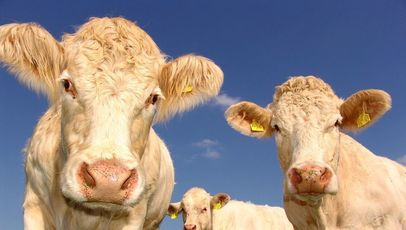|
Antibiotics (drugs designed to kill microbes such as bacteria) are routinely supplemented into beef cattle feed in order to prevent infection. However, there has been concern that wide use of antibiotics may encourage the growth of bacteria that are resistant to antibiotics, which are then more difficult to kill. This study by the USDA set out to examine if a 5 day dose of antibiotics (chlortetracycline) was useful in reducing infections among the cattle and to what extent it contributes to antibiotic resistance. Upon arrival from a breeding facility, 150 beef cattle were randomly assigned to a control group (normal feed with no antibiotics) and another 150 cattle were randomly assigned to the antibiotic group (10 mg/lb of body weight/day of chlortetracycline in their feed). After 5 days all animals were given feed without antibiotics. The health of the animals was evaluated by veterinarians. The amount of antibiotic-resistant bacteria was assessed by growing fecal samples on plates containing antibiotics (tetracycline or cefotaxime); any colonies that grew were counted as antibiotic resistant. The authors report that in the control group that did not receive antibiotics, more than 25% (38/150) of the animals became sick and had to be treated with antibiotics commonly used in human medicine. In the antibiotic group, only 1.3% (2/150) of the animals became sick and required treatment. The authors conclude that a 5 day antibiotic treatment keeps the animals healthier and can reduce the requirement of treating animals with antibiotics relevant for human health. Furthermore, there was no difference in the amount of antibiotic-resistant bacteria (E.coli) in the feces of the animals from the 2 groups. Therefore, the authors conclude that a 5 day treatment with the antibiotic chlortetracycline significantly reduces the chance of animals becoming sick without increasing the levels of antibiotic resistant bacteria in their feces. Original article can be found here: http://aem.asm.org/content/early/2016/10/03/AEM.01928-16.abstract Can't access the original article? Find out more details about this article on our database: http://www.opensciencedb.com/federal-agency-research-db.html#federal-research-db/medical-research-db-detail/58c89d05929fc92a6caa2f15/ |
AuthorsWe are grad students and scientists dedicated to disseminating Are you a student or postdoc? We need your help to deliver scientific facts to the public!CategoriesArchives |
|
|



